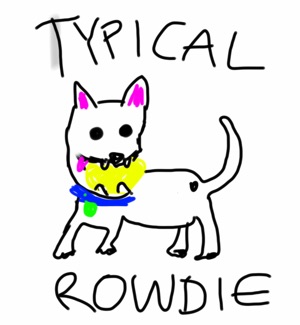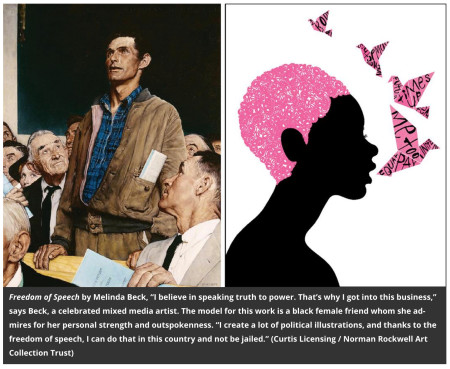Art. So Much More than Something Hanging on a Wall
We often forget how powerful the arts can be in connecting our kids with social studies content and big ideas.

Both my kids have always had a strong sense of art, of being able to create visually appealing pieces. (The Rowdie effort to the left by the oldest is not one of his best efforts, though it does accurately convey the family pet’s personality.) We constantly had crayons, painting supplies, easels, and all sorts of other artsy things in use around the house.
I wasn’t much help. My art skills have been described as “creative” and “abstract.”
Both kids continue to share their love for the medium and to help me think about art and artists. And today, a quick conversation with a high school US history teacher meandered down a path that focused on ways to integrate art into our instruction.
So it got me thinking a bit.
We often forget how powerful the arts can be in connecting our kids with social studies content and big ideas. Art, in all of its forms, is a great way to create emotion, generate connections, and build relationships. Whether viewing landscapes, portraits, or historical events through the eyes of contemporary artists, students can get a sense of time, of place, of interpretation that would be impossible using other forms of primary sources.
One of the quickest ways to incorporate the arts is to focus on the visual – paintings, drawings, and images. But I often notice it missing from the toolkits of many social studies teachers. And I’m not exactly sure why. Maybe we’re just not aware of the resources available or the kinds of questions to ask. If we’ve never thought too much about using artwork as an instructional tools, it can be hard finding a jumping off point.
So what can it look like when we intentionally integrate visual art into our classrooms? Try some of these ideas and resources:
Tools and ideas to transform education. Sign up below.

Norman Rockwell has always been a favorite. So maybe start with this powerful example of helping kids envision his Four Freedoms embedded in the 1st Amendment using this article I wrote earlier this year.
Then head over to all of the different Smithsonian art museums for lessons, graphic organizers, and primary source sets designed just for teachers:
The National Council for the Social Studies has some helpful journal articles:
- Using Art to Teach History to Young Learners
- Creating Connections: Integrating the Visual Arts with Social Studies
The Kennedy Center instituted ArtsEdge as its educational media arm, reaching out to schools, communities, individuals and families with printed materials, classroom support and Internet technologies. They also have a handy mobile app.
EDSITEment is a partnership between the National Endowment for the Humanities and the National Trust for the Humanities and offers a treasure trove for teachers in the subject areas of literature and language arts, foreign languages, art and culture, and history and social studies.
The Social Studies Arts Toolkit includes multimedia resources designed for use in K-12 social studies and arts classrooms. Be sure to browser through their nice PDF document of strategies.
And like my quick conversation earlier this morning, all of this stuff lends itself nicely to some engaging and powerful professional learning discussions with your peers. So during that next awkward silence in your department meeting, don’t be afraid to kickstart a discussion on how Leutze’s use of color and shading in his 1861 Westward the Course of Empire Takes Its Way is indicative of America’s moral values during western expansion.
cross posted at glennwiebe.org
Glenn Wiebe is an education and technology consultant with 15 years' experience teaching history and social studies. He is a curriculum consultant forESSDACK, an educational service center in Hutchinson, Kansas, blogs frequently at History Tech and maintains Social Studies Central, a repository of resources targeted at K-12 educators. Visit glennwiebe.org to learn more about his speaking and presentation on education technology, innovative instruction and social studies.
